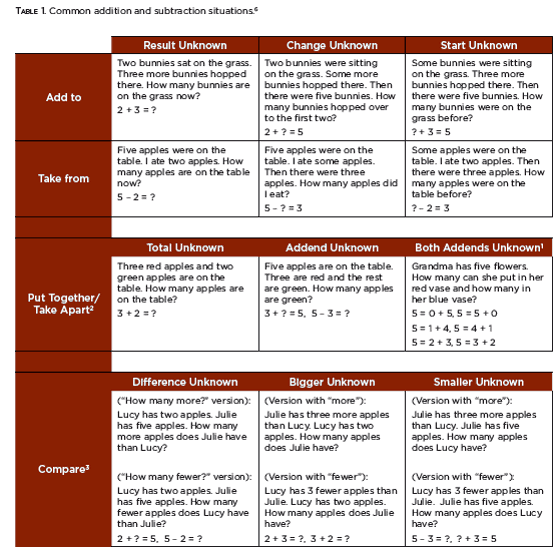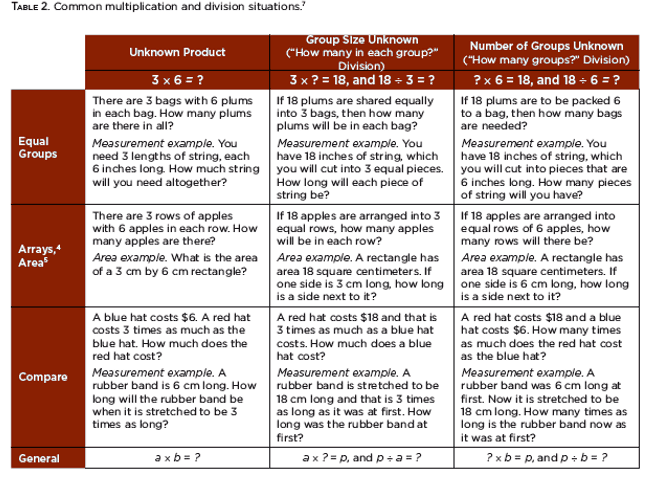Editor’s Note: All of the documents discussed by the author can be found on Achieve the Core here.
When Florida adopted the Common Core State Standards for Mathematics (CCSSM), my school district adopted GO Math! from Houghton Mifflin Harcourt (HMH). It did not take long for our coaches to realize there were alignment issues and gaps in the GO Math! curriculum. For example, while working with teachers on unit planning, we discovered that the GO Math! series does not adequately represent the various problem situations as called for in Table 1 and Table 2 in the Common Core State Standards Mathematics Glossary (Common Addition and Subtraction Situations and Common Multiplication and Division Situations).
With an increased awareness of the CCSSM and of the limitations of their textbook, teachers frequently seek help from our math coaches to clarify the intent of the standards and verify the alignment of various textbook lessons. Teachers often complain, rightfully so, that they do not have enough time to pour through each lesson to determine if it is aligned and make modifications or find substitute lessons. Thanks to Student Achievement Partners (SAP) and the Materials Adaptations Project (MAP), teachers using GO Math! now have the needed resources to fulfill this huge request.
In April, at the recommendation of my Math Specialist, I participated in Student Achievement Partners’ Materials Adaptations Project. Educators from across the country and representatives from HMH and TNTP participated in MAP to improve the alignment of GO Math! with the CCSSM and to fill critical gaps found in GO Math!. Under the guidance of members from SAP, grade-specific teams worked to generate Rules of Thumb (tips for improved usage of the textbook’s recurring features), grade-specific adaptations, and fluency resources to assist teachers using GO Math!.
The MAP Guidance Documents include an overview of strengths and weakness of GO Math! For the most part, this group determined that GO Math! is generally aligned to the CCSSM with the majority of instructional time devoted to the Major Work in each grade level. Various computational strategies and models are represented in the series to build conceptual and procedural knowledge. The educators in the MAP group determined, however, that more work was needed to identify the few lessons that did not fully develop the CCSSM or belonged in other grade levels.
Program-Level Rules of Thumb
One outcome of the work completed by each grade-level specific team, was the generation of Program-Level Rules of Thumb to provide suggestions for using features that appear across the GO Math! K-5 program. For example, a Program-Level Rule of Thumb applies to the presentation of the “Unlock the Problem/Listen and Draw” feature that begins most lessons. When the guiding questions in these sections are used to lead students through the problem solving process, they remove the creative nature of problem solving. Students are no longer engaged in productive struggle. Innate problem-solving strategies that students develop are less likely to surface as the guiding questions lead students to think one way. It is recommended that teachers present the problem concealing the guiding questions from the students to give them an opportunity to come up with their own strategy first. Teachers can use the guiding questions while circulating from group to group or while leading a discussion during the lesson debriefing at the end of the lesson, during which time students share and discuss their strategies they used to solve the problem.
This simple adaptation of the textbook supports the Eight Effective Mathematics Teaching Practices from Principles to Action, especially “Implement tasks that promote reasoning and problem solving,” “Use and connect mathematical representations,” “Facilitate meaningful mathematical discourse,” “Pose purposeful questions,” “Support productive struggle in learning mathematics,” and “Elicit and use evidence of student thinking.”
Grade-Level Rules of Thumb
Grade-Level Rules of Thumb were also generated by each group to address grade-specific features of GO Math!. An example of a Grade-Level Rule of Thumb is for second grade teachers to delete most of Chapter 1 because it aligns more to a first grade standard. Instead, it is recommended that teachers start the year teaching Chapter 3. The extra time gained through this adaptation can be devoted to helping students meet the end of the year benchmark goal of being fluent with all addition and subtraction facts within 20 (2.OA.B.2) I have to admit, as a coach, I appreciate the boldness behind such a recommendation. Now, coaches have the collective thoughts of many educators to help convince teachers to carry out such recommendations.
Grade-Specific Guidance Documents
Another outcome of the work completed by the MAP educators is the creation of Grade-Specific Guidance Documents. Grade-level groups examined each lesson in the GO Math! textbooks to determine if it fulfilled the intentions of the standard on which it was based. Decisions to delete, keep, modify or replace each lesson were made by the grade level teams. Links to Open Educational Resources (OER) are provided to support lesson modifications or to replace problematic lessons with better ones. One example of a replaced lesson is fourth grade lesson 2.3 which creates a rule for adding a zero at the end of a multiplication problem as if it magically appears. This is one misconception that I address repeatedly as a coach: “30 x 7” is not the same as “3 x 7 and stick a zero at the end.” The lesson is replaced with a lesson from EngageNY that emphasizes place value strategies and strategies based on the properties of the operations.
Math Fluency Resources
The Grade-Specific Guidance Documents also include fluency recommendations within the Grade-Level Rules of Thumb. Separate fluency documents, Resources for Developing Grade-Level Fluencies, were created to support the fluency standards within each grade level. The short activities within the document promote student progress in the mastery of these standards. In second grade, for example, the teacher can use 2 minutes engaging students in the chant “Related Facts Within 20.” The teacher states a subtraction expression, such as 7 – 4; the students respond by chanting 4 + 3 = 7. In my experience, teachers love these simple easy-to-implement activities that can be used to fill that odd extra minute or two found at various times throughout the day.
Implementing
As a result of our work during MAP, we have improved the alignment of the GO Math! textbook with the CCSSM. Preliminary teacher reaction to this work has been tremendous. While delivering math PD this summer, I took advantage of the captive audience and teased them with a bare bones introduction to this work. Even without specific details, the teachers unanimously agreed this work would be tremendously helpful
A big question remains, though: How do school districts share this information with teachers? Do we send out an e-mail with a very brief explanation and a link hoping someone in each grade level will take a moment to open the resource, check it out, and realize how helpful these resources could be? I hope not. We need to do more to encourage teachers to make use of these resources in their planning. Although my district has not yet made specific plans to share this work, we have generated some ideas. We could create a brief video or webinar highlighting the resources created. The video/webinar would be posted on the district TV channel for teachers to view at their leisure, during a math PLC, or under the guidance of the school’s Learning Specialists during a curriculum meeting. As a traveling math coach, I have the opportunity to share this work with teachers at each school I visit. Coaches and teachers could use the Guidance Documents during unit planning. A fun way to share this information with a school faculty could be to create a scavenger hunt for teams to discover the contents of the resources created in the MAP. Whatever method districts use to disseminate this information, I know their teachers will be grateful for this valuable resource.
If you’re interested in pursuing this kind of work with a different series at your own school or district, check out Achieve the Core’s process recommendations for Adapting Materials http://achievethecore.org/aligned/outcomes-of-the-adaptation-process/



















How can I access these documents?
Hi Kenyartta,
All of the adaptation materials for K-5 Go Math! adaptations can be found here: https://achievethecore.org/page/2853/go-math-k-5-guidance-documents.
Do you have the Guidance Documents for 6th Grade Go Math?
Unfortunately we do not have adaptation materials for 6th grade.
Do you anticipate creating 6th grade adaptation materials in the future,?
Hi Luanne, No plans to add grade 6 at this time, but we recommend looking at the Rules of Thumb within the earlier grades’ adaptations for ideas on how to adapt grade 6.
This is awesome- Is there one available for grade 5 Pennsylvania?